What can we learn from the highest earning indie developers on Steam?
Mar 14, 2022Only 10% of Steam developers have ever made more than $100k in gross revenue. This article explores what they’re doing that other developers aren’t. It covers self-publishing, genre focus, number of games developed and more.
50 shades of indie developers
The last article I published covered all of the 44,000 developers on Steam. It showed how many games they publish, how much money they make, what genres they focus on etc. It’s an interesting starting point, but what really interested me was to see if the top developers stand out in any way.
This article buckets Steam developers into 5 categories based on their lifetime earnings on Steam:
- <$1k – The Learner – Developers who have typically released only 1 game and it’s… umm… not good.
- $1-10k – The Hobbyist – Developers whose games have sold some units, but have never done very well.
- $10-100k – The Indie – This is the core of indies – they’ve made some money out of their games, but typically not enough to make this a full-time career.
- $100k-1m – The Full-timer – These indies have made enough with their game(s) that they can make it as a full-time indie developer.
- >$1m – The Success Story – These indies have done it. They’ve made over $1m in gross revenue. They’re typically a team, not a solo dev. Life’s good. That’s until you take off the Steam cut, the returns, the taxes, the year(s) it took to develop the game… Still, this group of developers has done well and they’re definitely in the minority.
We’ve also excluded the couple of hundred AAA and AA developers – the Ubisofts, SEGAs and THQ Nordics.
There are few games that make a lot of money
To set the scene, let’s cover how many developers of each bucket we have.
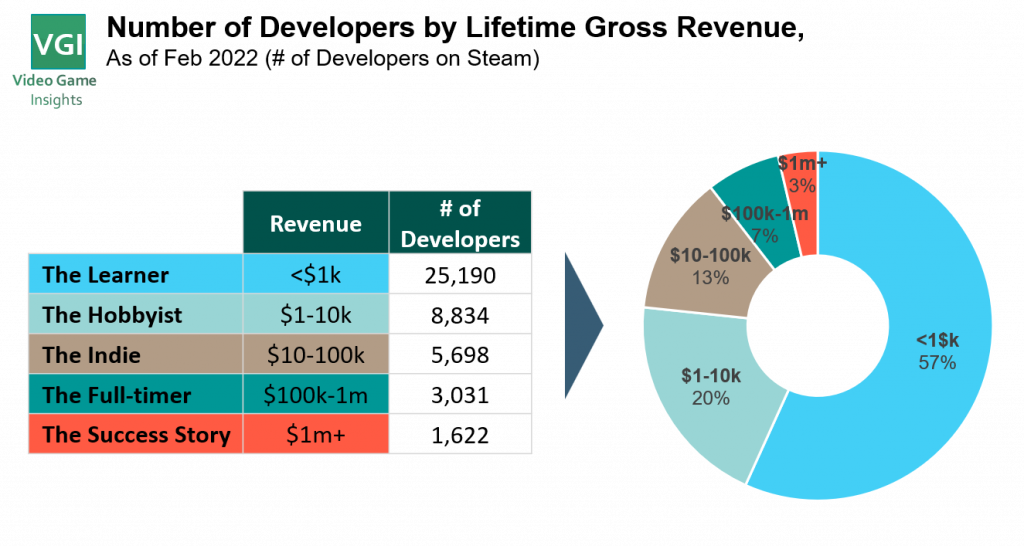
Yes, only 3% of indie developers ever make more than $1m, but that’s still over 1,500 indies who have done so. Let’s see what they do that others don’t.
Top developers don’t give up and keep publishing games
The Success Story’s average revenue per game is a lot higher than that of smaller or less successful developers. That’s not necessarily big news. The success stories, on average, have made over $3m per game.
Much more importantly, though, successful developers also make more games.
The learners and hobbyists have typically made 1-2 games on Steam. And that doesn’t necessarily result in instant success, so a lot of new developers end up giving up.
The Success Stories have, on average, released 4-5 games, many of them much more than that. Not all of their games end up being successful, but they keep going.
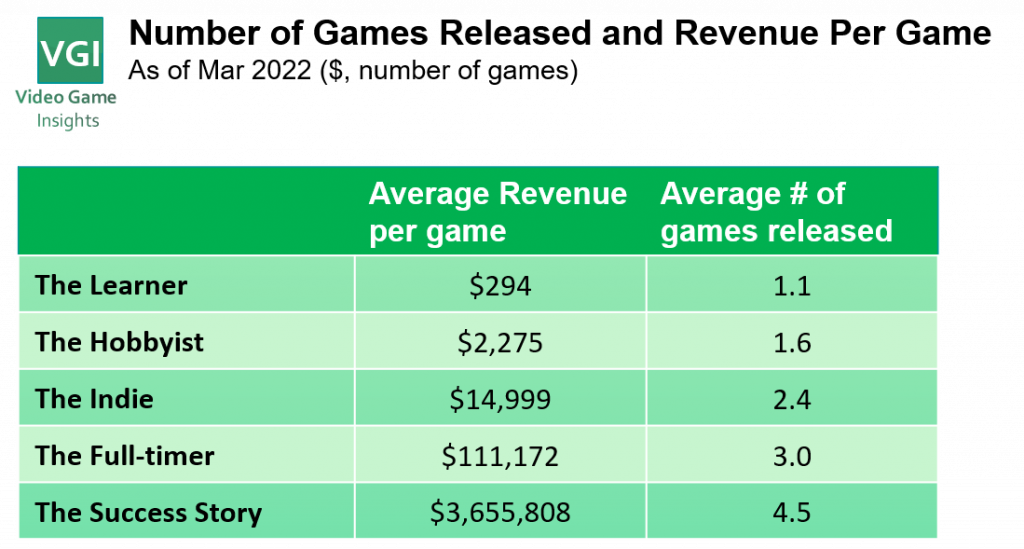
Take Reiza Studios, for example. They’re a Brazilian game development studio focusing on making realistic racing games. Their first game, Formula Truck 2013, was released in 2013 and made <$100k. Since then, each game they’ve released has made more money than the previous. Automobilista 2, released in 2020, has made millions.
Unfortunately, this also sometimes works the other way around. Game developers with initial success end up releasing new games that don’t reach nearly the same level of success. Key take-away? You don’t always know what ends up a hit, especially with limited marketing budgets. Successful developers keep making games to increase the chance of making a successful release.
Top developers leave publishing for someone else
Know what you’re good at and leave the rest to others. That’s what the top indies seem to have learned.
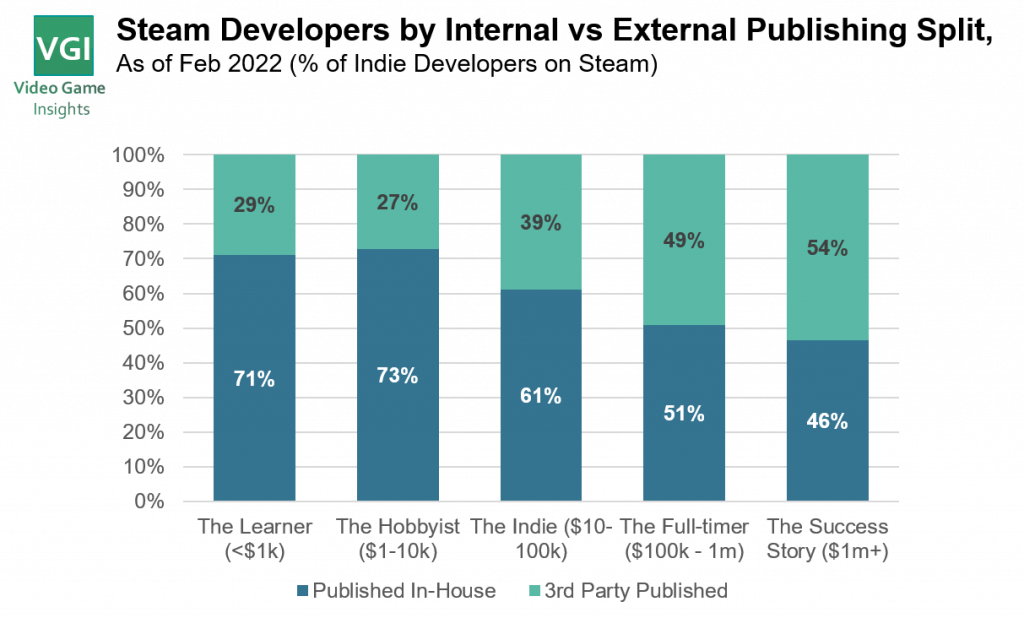
Small indies seem to mostly self-publish games (c. 70-75% in-house).
The more successful indies seem pretty evenly split between releasing their own game vs going with a publisher.
Of course, this works both ways. Good indie developers are more likely to focus on development and reach out to a publisher AND good games are more likely to get publishers’ attention.
There is definitely value that good publishers with the right fit can bring to indie developers, especially if the indie developer has limited marketing experience themselves.
Top developers specialise
There are strong synergies in making games in similar genres.
- Build-up of assets – Developers can use elements of previous games, whether it’s code or art base, to significantly simplify the development process going forward. It’s less applicable if the game is in a different genre, or even in a different style. Going from 3rd person to 1st person can be a significant effort alone.
- Build-up of knowledge – The studios that specialise just learn more about the particular genre’s details. You know how Malcom Gladwell told you it takes 10,000 hours to master something?
- Build-up of connections – Focusing on a specific type of games allows you to build up a network of support in that space – from aligned publishers to likeminded developers.
- Build-up of fans – Your players know what they get. That’s a massive bonus. Whenever Paradox Development Studios releases a new game, I know I’m going to love whatever grand strategy they’re coming out with this time.
Top developers understand that. Look at any top indie studio out there and you’ll see a strong signature and style that is consistent across games – from genre to art style to camerawork.
On the other extreme you have the Learners and Hobbyists who are still developing their style. They explore many genres and types of games before they settle on the one that suits them well.
Top developers pick the right genres
Top developers tend to make 2D platformers. Oh, wait. No, they don’t.
Top developers have figured out that Steam players like strategy, sim and maybe sometimes FPS games. You’ll see more top developers focus on these genres.
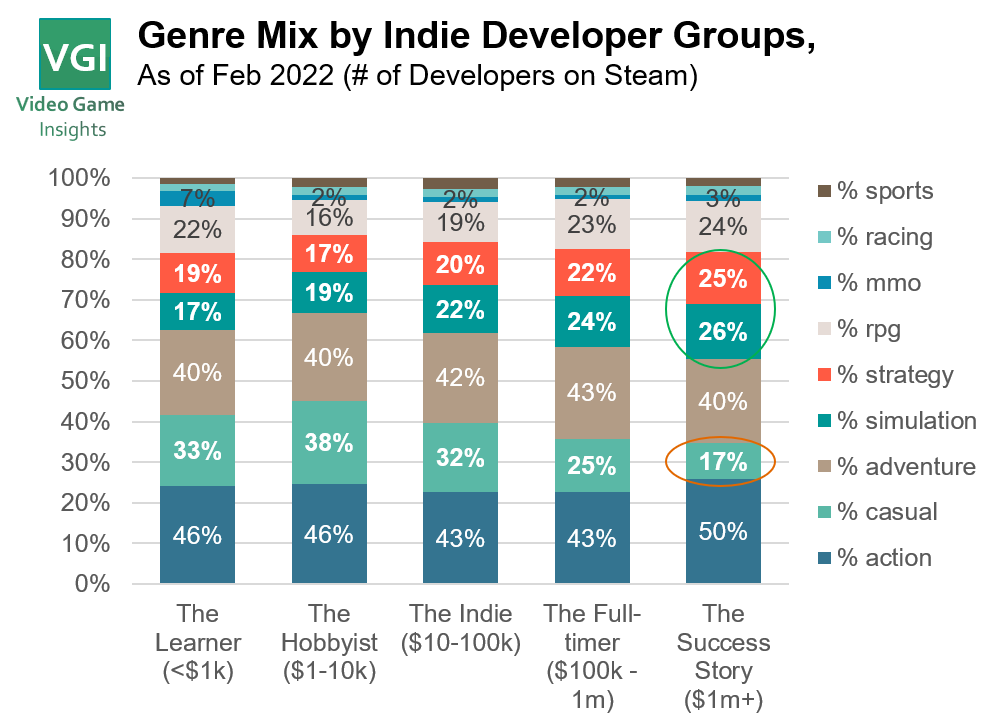
Note that these bar charts don’t add up to 100% for the developer type as some games fall under several genres. Each number indicates what % of developers’ games, on average, fall under that particular genre.
The Success Stories are much more likely to develop strategy and simulation games (c. 50% of games by the Success Stories being of these genres vs only 36% for The Learners and The Hobbyists). The Success Stories are also significantly less likely to develop casual games (17% vs 38% of Hobbyists).
This is why market research before making a game is important. Knowing that your sub-genre is popular upfront makes a difference.
Top developers adapt to changing player preferences
When looking at popular genres and sub-genres, it’s also important to consider the current Steam top charts. Looking at 2022 top grossing games as of March for example, we can see that action games have been incredibly successful – 7-10 of the top selling indie games have action elements. A lot of them also have co-op / multiplayer elements.
On top of general platform genre preferences, recent trends need to be considered.
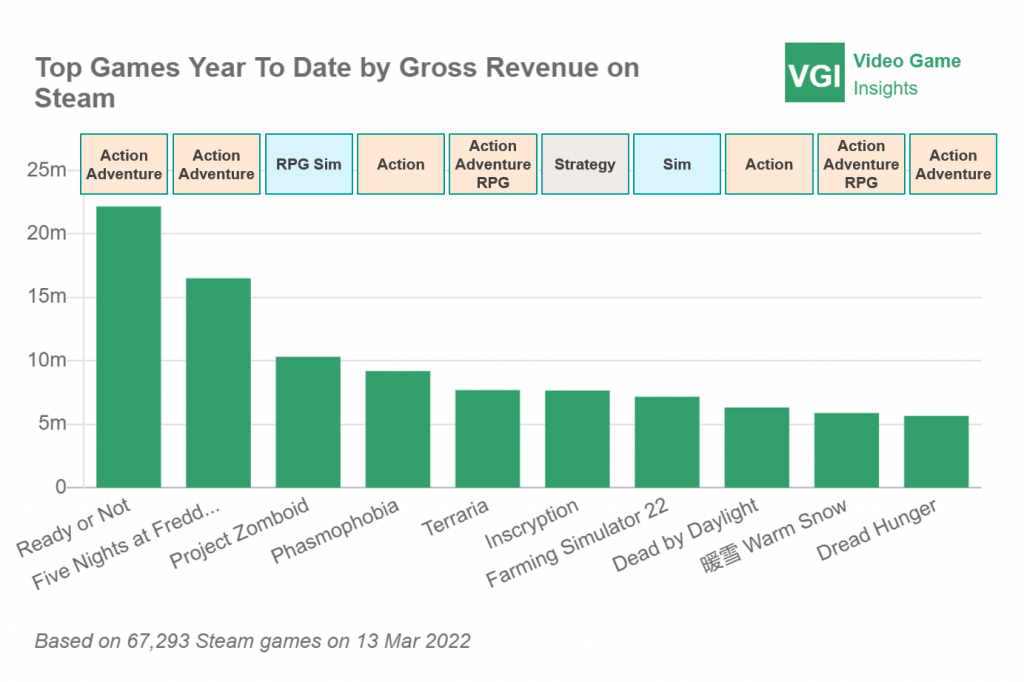
Note that this doesn’t mean that the top developers always make whatever they think is going to be the next hot genre. Specialisation remains important. But they can adjust some elements of the game to fit the players’ expectations.
Summary
What have we learned from looking at the top developers in an analytical way?
There’s no magic formula to being a successful developer, but the trends are pretty clear.
- Successful developers make a lot of games
- Successful developers find publishers, so they can focus on what they’re good at
- Successful developers specialise
- Successful developers focus on genres that do well
- Successful developers adapt to changing player preferences
This article was originally published on the Video Game Insights blog. VG Insights is a Steam market research platform focusing on helping indie developers make better decisions. We have recently released a Steam top charts page, showing which games are most played or generate the highest revenue.